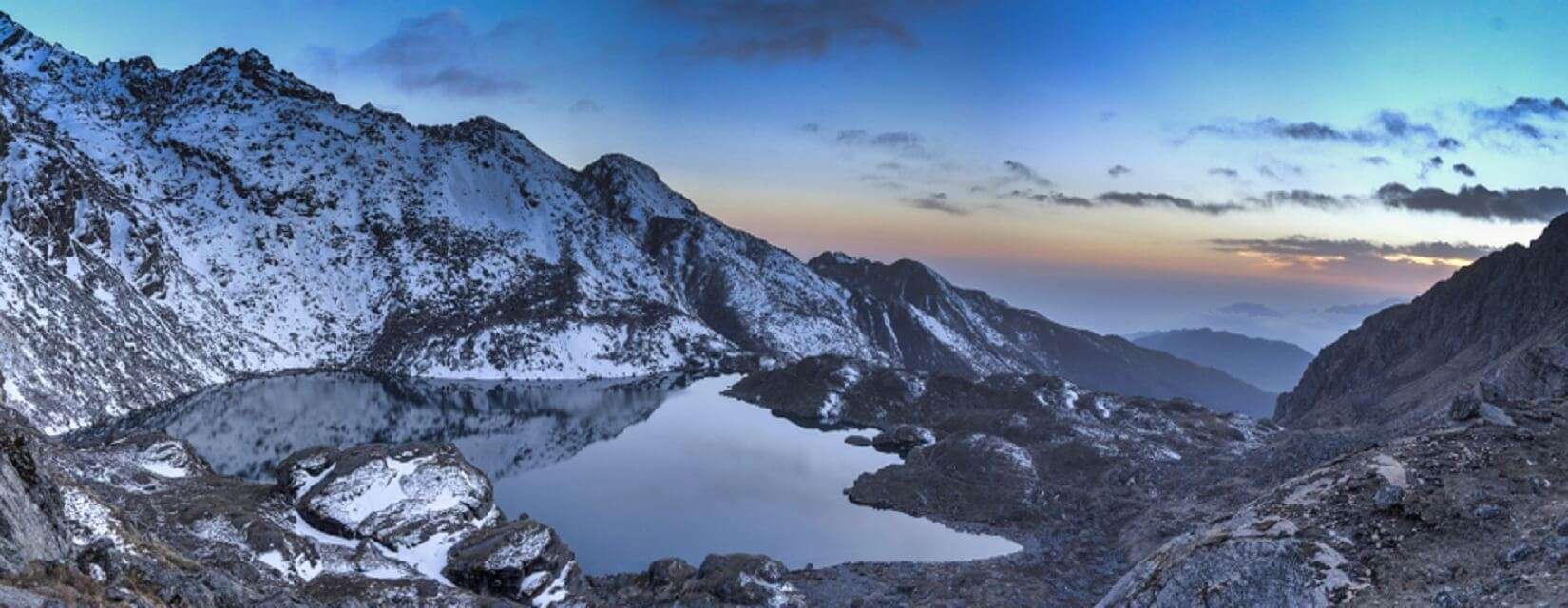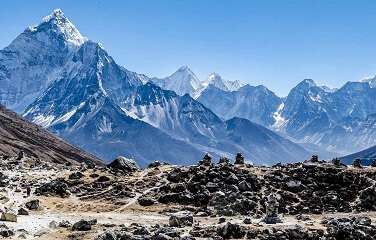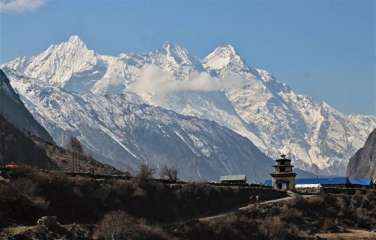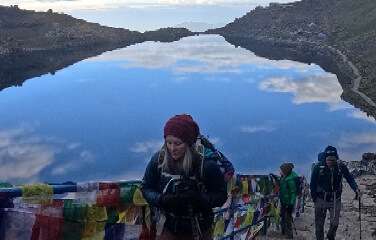The Spiritual Significance of Gosaikunda Lake

The Legend of Gosaikunda
Gosaikunda is deeply entwined with Hindu mythology. According to legend, the lake was created by Lord Shiva when he thrust his trident into the mountain to extract water and quench his thirst after consuming poison. This poison was the result of the churning of the ocean (Samudra Manthan), which threatened to destroy the world. The poison turned Shiva's throat blue, earning him the name "Neelkanth." The creation of Gosaikunda is symbolic of the divine intervention of Shiva to protect the universe, making the lake a site of immense spiritual importance.
Religious Pilgrimage and Festivals
Gosaikunda is one of the most important pilgrimage sites for Hindus, especially during the Janai Purnima festival, which falls in August. During this festival, thousands of devotees from Nepal and India trek to the lake to perform ritualistic bathing in its icy waters, believing it to purify the soul and cleanse sins. The festival also marks the changing of the sacred thread (Janai) worn by Hindu men, symbolizing renewal and purification.
Buddhists also hold Gosaikunda in high regard, associating it with the Bodhisattva Avalokiteshvara. The lake is considered a source of spiritual power and is visited by Buddhist monks and nuns as part of their meditative retreats.
The Journey Begins – Reaching the Trailhead
Kathmandu to Dhunche: Gateway to Langtang
The trek to Gosaikunda typically begins with a drive from Kathmandu to Dhunche, a small town that serves as the gateway to Langtang National Park. The drive itself is an adventure, winding through scenic landscapes, terraced fields, and traditional villages. As the road ascends, the views of the distant Himalayas become more pronounced, building anticipation for the journey ahead.
Dhunche is the administrative center of the Rasuwa District and offers basic amenities such as guesthouses, shops, and permits offices. Trekkers usually spend a night here to acclimatize and prepare for the trek.
Permits and Preparations
Before starting the trek, trekkers must obtain the necessary permits. The Gosaikunda trek requires both a Langtang National Park entry permit and a TIMS (Trekkers' Information Management System) card. These can be acquired in Kathmandu or Dhunche. It's also advisable to check weather conditions and ensure that you have the appropriate gear, as the weather can be unpredictable, especially at higher altitudes.
The Trekking Experience

Dhunche to Sing Gompa
The trek from Dhunche to Sing Gompa is the first leg of the journey and offers a gradual ascent through dense forests of oak, pine, and rhododendron. The trail winds through traditional Tamang villages, where trekkers can experience the warm hospitality of the local people. The Tamang community, with its rich culture and traditions, adds a unique cultural dimension to the trek.
Sing Gompa, also known as Chandanbari, is a small settlement that is famous for its cheese factory and ancient monastery. Trekkers can visit the monastery to seek blessings for their journey ahead. The cheese produced here is renowned throughout Nepal, and tasting it is a must for anyone passing through.
Sing Gompa to Laurebina Yak
The next segment of the trek takes you from Sing Gompa to Laurebina Yak. As the altitude increases, the landscape begins to change, with the forests giving way to alpine meadows and barren terrain. The trail becomes steeper, testing the endurance of trekkers, but the breathtaking views of the Langtang and Ganesh Himal ranges provide ample motivation.
Laurebina Yak is a small rest stop with a few teahouses where trekkers can rest and acclimatize. The name "Laurebina" translates to "without a stick," referring to the challenging nature of the trail that leaves trekkers needing a walking stick for support. At this altitude, the air becomes thinner, and trekkers may start to feel the effects of altitude sickness, making acclimatization crucial.
Laurebina Yak to Gosaikunda Lake
The final ascent to Gosaikunda Lake is both challenging and rewarding. The trail becomes steeper and more rugged as it approaches the lake, passing through rocky terrain and small glacial ponds. The altitude here is over 4,000 meters, and trekkers must pace themselves to avoid altitude sickness.
As you approach Gosaikunda, the first glimpse of the sacred lake is a sight to behold. The turquoise waters of the lake, surrounded by snow-capped peaks, create a serene and almost otherworldly atmosphere. The lake is frozen for most of the year, except during the summer months when the ice melts, revealing its crystal-clear waters.
The Spiritual Experience at Gosaikunda

Rituals and Offerings
Upon reaching Gosaikunda, many trekkers and pilgrims perform rituals and make offerings to Lord Shiva. The lake is dotted with shrines and tridents, placed by devotees as a mark of their pilgrimage. Some pilgrims take a dip in the freezing waters, believing it to be a purifying act that cleanses the soul and brings them closer to the divine.
The atmosphere around the lake is one of peace and reverence. The sound of prayer bells and the chanting of mantras echo through the mountains, creating a spiritual ambiance that is palpable. Trekkers often find themselves drawn into the rituals, participating in the offerings and prayers, regardless of their religious beliefs.
Meditation and Reflection
For those seeking a deeper spiritual experience, Gosaikunda offers an ideal setting for meditation and reflection. The tranquility of the lake, combined with the majestic backdrop of the Himalayas, provides a perfect environment for introspection. Many trekkers spend time sitting by the lake, contemplating life and absorbing the spiritual energy that permeates the area.
The journey to Gosaikunda is not just a physical trek but also a spiritual one. The challenges faced on the trail, the encounters with local culture, and the experience of the sacred lake all contribute to a profound sense of connection with nature and the divine.
The Return Journey and Beyond

Gosaikunda to Sundarijal via Helambu
After spending time at Gosaikunda, trekkers have the option to return the same way or continue the trek towards Sundarijal via the Helambu region. The Helambu trek offers a different experience, with the trail passing through lush forests, terraced fields, and traditional villages inhabited by the Hyolmo people.
The descent towards Sundarijal takes trekkers through a variety of landscapes, from alpine meadows to subtropical forests. The trail is less crowded, offering a more peaceful trekking experience. Sundarijal, located on the outskirts of Kathmandu, marks the end of the trek, where trekkers can relax and reflect on their journey.
Alternative Routes and Extensions
For those with more time and a desire to explore further, there are several alternative routes and extensions to the Gosaikunda trek. One popular option is to combine the Gosaikunda trek with the Langtang Valley trek, which takes you through the heart of Langtang National Park and offers stunning views of the Langtang Lirung and other peaks.
Another option is to extend the trek to the Tamang Heritage Trail, which provides an in-depth cultural experience, allowing trekkers to immerse themselves in the traditions and lifestyle of the Tamang people.
Best time to go to Gosaikunda Lake
The best time to trek to Gosaikunda Lake is during the spring (March to May) and autumn (September to November) seasons. These periods offer the most favorable weather conditions, making the trek safer and more enjoyable. Here’s why:
Spring (March to May)
Weather: The weather is generally mild, with clear skies and pleasant temperatures. Daytime temperatures in lower elevations range from 10°C to 20°C (50°F to 68°F), while higher elevations near the lake can be colder, especially at night.
Flora: The spring season is marked by the blooming of rhododendrons and other wildflowers, adding vibrant colors to the landscape. The lush greenery and colorful blossoms make the trek particularly scenic.
Views: Clear skies provide excellent visibility of the surrounding mountain ranges, including Langtang and Ganesh Himal.
Autumn (September to November)
Weather: Autumn is considered the best time for trekking in Nepal due to stable weather conditions and moderate temperatures. Daytime temperatures are comfortable, ranging from 10°C to 20°C (50°F to 68°F) in lower elevations, with cooler temperatures at higher altitudes.
Views: This season offers some of the clearest views of the Himalayas, with crisp air and minimal cloud cover. The post-monsoon period also ensures that the landscapes are lush and vibrant.
Festivals: Trekking during this time allows you to experience local festivals like Dashain and Tihar, adding a cultural dimension to your journey.
Winter (December to February)
Challenges: While it's possible to trek to Gosaikunda in winter, this season brings cold temperatures, especially at higher altitudes, and the possibility of snow, which can make the trail slippery and difficult. The lake is often frozen, and accommodations may be limited due to fewer trekkers.
Monsoon (June to August)
Challenges: The monsoon season brings heavy rainfall, making the trails muddy and slippery. There's also a higher risk of landslides in certain areas. However, the landscape is lush and green, and the trek is less crowded. Be prepared for leeches and limited mountain views due to cloud cover.
For the best experience, it’s recommended to plan your trek during the spring or autumn seasons when the weather is most favorable, and the natural beauty of the region is at its peak.





